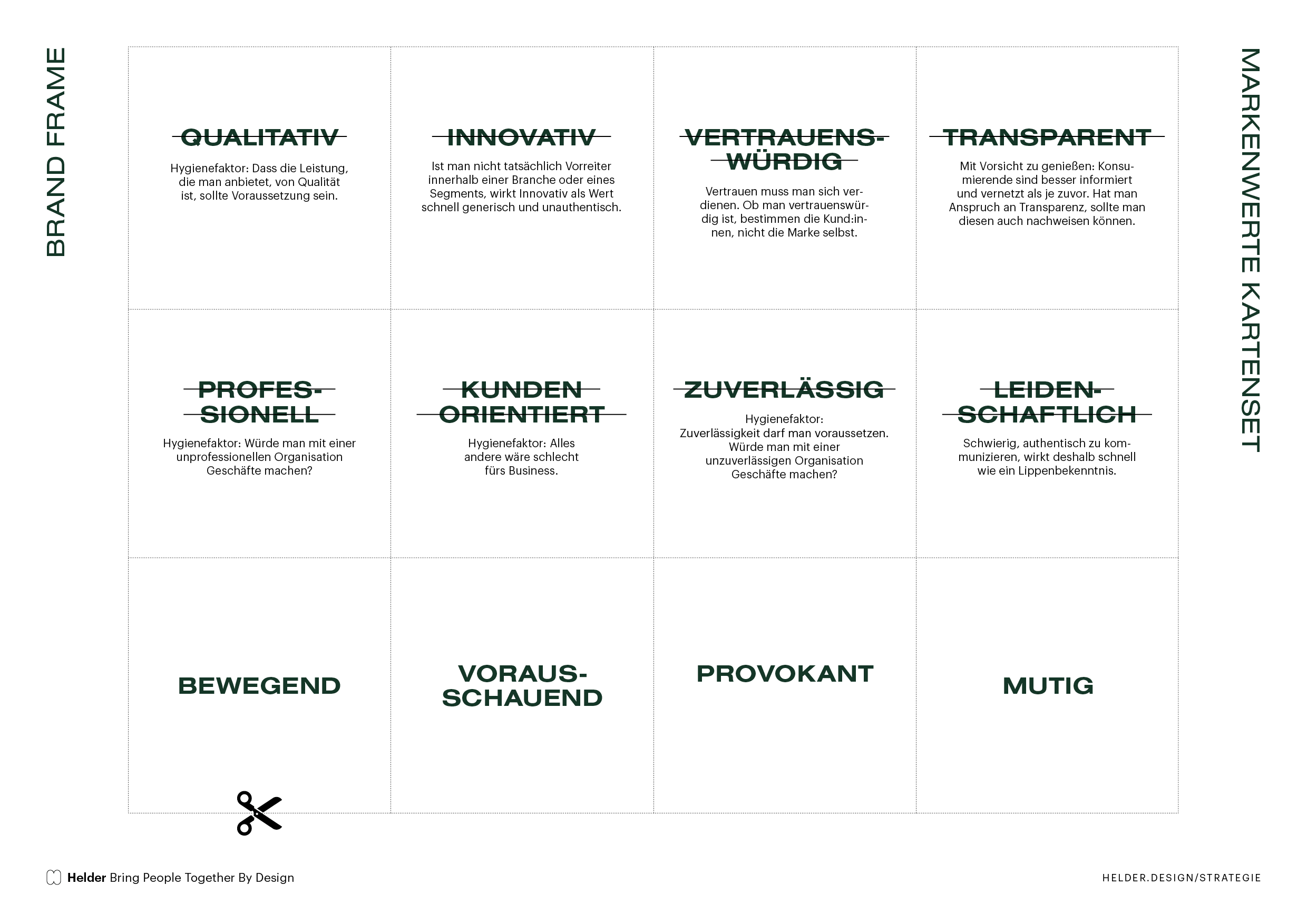Definition of brand values
Brand values are important elements of brand management that help determine the identity of a brand. Brands that are perceived by certain groups as a sign of belonging benefit from a recognizable attitude, as this creates identification opportunities. A clear attitude and a set of values position companies not only in the market, but also in society. By clearly communicating and applying their values, brands can build trust, ensure self-similarity both internally and externally and thus retain the loyalty of their target group in the long term.

Brand values are not a nice-to-have – they are a statement
Why are brand values important?
We live in a world with an unmanageable range of goods and services, most of which differ only marginally in terms of quality. A mass of information and impressions makes it increasingly difficult for customers to make a purchase decision.
Needs have long since developed into wants.
In this world, it is no longer sensible, if not impossible, to differentiate a product solely on the basis of its rational benefits: The risk of buying certain product categories has shifted from a material risk to an idealistic and social risk. Brands must therefore create meaning and offer a subjective benefit for customers in addition to rational benefits. Brand values are the basis for orientation in a wide range of brands.

Brand Personality Sliders Vorlage helps to get a feel for the brand.
Define brand values in 3 steps
As part of the brand strategy, it is important to develop a differentiated brand personality. Brand values are an important element in shaping the identity of a brand. The value system of a brand should be reflected in the entire corporate philosophy and culture in order to convey an authentic image to the outside world. Customers associate strong brands with emotional content, visual images and associations. Clear customer positioning requires a clear brand identity. When developing brand values, it is important to look inwards, remain authentic and work out special features that go beyond product characteristics.
A long list of values is not useful because no one will remember them – neither employees nor customers. Imagine your values are tennis balls that you throw to someone at the same time: the more there are, the lower the chance that he or she will catch one. It is more helpful if the brand is associated with a strong value, the One Word Equity.
1. Collect values
To find out what the brand is about at its core, first look at the brand from three perspectives:
- What one word would the team use to describe the brand?
- What one word would customers use to describe the brand?
- Which one word describes the brand from your own perspective?
Brainstorm for yourselves which one word per perspective best describes the brand’s performance and attitude. Avoid generic terms or hygiene factors such as quality or trust. Example: The fact that a software developer is agile is obvious and has little differentiating effect in the market environment (unless he sets noticeable standards in terms of agility). Instead, look for terms with fewer connotations. Pay attention to this:
Authenticity: Brand values must be authentic. It is a process of self-awareness, taking into account special features, capabilities and performance. What is typical about a brand’s products or the way in which the products are developed?
Value orientation vs. product orientation: Value-oriented thinking goes beyond production: the special, outstanding and unique aspects of a brand form an attitude and the reason why people commit to it or not.
Credibility: Brand core values will only be appreciated if they can be communicated in a credible and differentiated manner. People don’t buy into overly generic, interchangeable values, just as they don’t buy into exaggerated, untrustworthy lip service that is not lived. If a brand positions itself as innovative, the products should really be pioneers in the market. Pretence is quickly exposed, as consumers are better informed and networked than ever before.
2. Evaluate and reduce values
Select one term per category that seems most appropriate. In this way, you work out the attributes that most participants can agree on. In the end, only the attribute per category that received the most points should remain.
Example value wheel for the e-commerce company benuta
3. Define the brand core In the next step, transfer the three identified values to the brand wheel. The core value is now generated from these three values: Discuss what the three terms have in common and extract the value that the brand stands for at its core. To ensure that the core value is associated with the brand in the long term, it is used consistently in the brand presentation at all touchpoints. Assuming the core value is “clarity”: How does clarity feel? What does it look like? What does a text that conveys clarity look like?
A brand is not what you say it is. It’s what they say it is.
Marty Neumeier
Brand values in times of skills shortages
In times of a shortage of skilled workers, it is crucial for companies to stand out from the competition, attract qualified talent and retain them in the long term. The clear communication and implementation of brand values plays a decisive role here. By communicating their values authentically and implementing them in their working environment, companies create an attractive corporate culture that appeals to talented specialists. Employees who can identify with their employer’s values are more willing to make a long-term commitment and contribute to the long-term success of the company.

The diversity campaign positions BVG as a modern employer
Bringing brand values to life
The value system of a brand should be reflected in the entire corporate philosophy and culture in order to convey an authentic image to the outside world. Customers associate strong brands with emotional content, visual images and associations. These companies manage to make their core brand values tangible in all contact opportunities, and brand values can also provide orientation for process or product development. What does a clear process look like? What is needed for emphatic customer service? How do you cover diversity in the product portfolio? And how do you integrate joy across the entire customer journey? Because only what people actually perceive contributes to strengthening the relationship with the brand. The aim of a successful BRAND STRATEGY is to gain trust in the brand values: people no longer check whether Apple has an innovative edge – they believe it.
Conclusion: Values make brands relevant
As a Brand Consulting or Brand Agency, we recognize true values. In our BRAND WORKSHOPS, we consistently challenge and identify your brand values.
Who am I, and if so, how many? We will find out.

